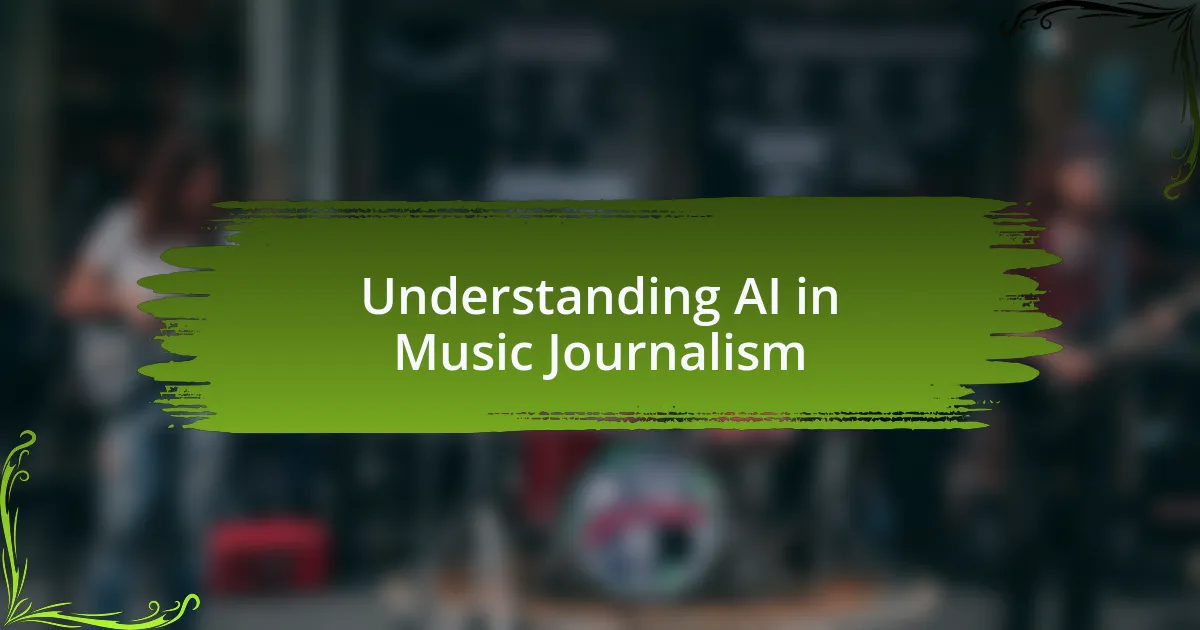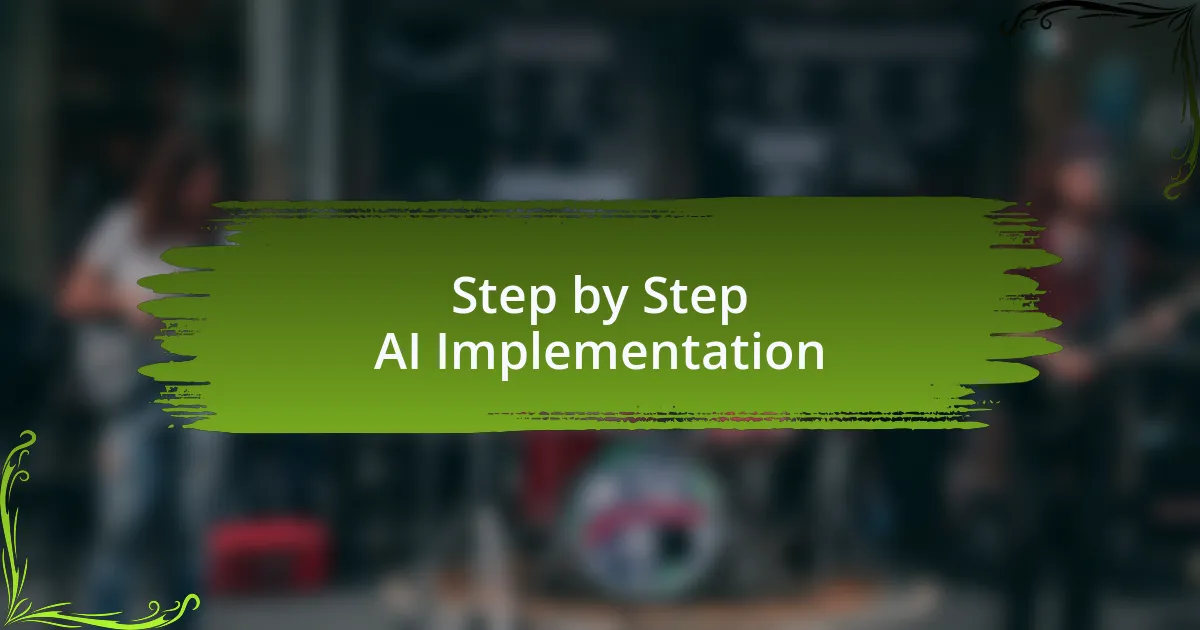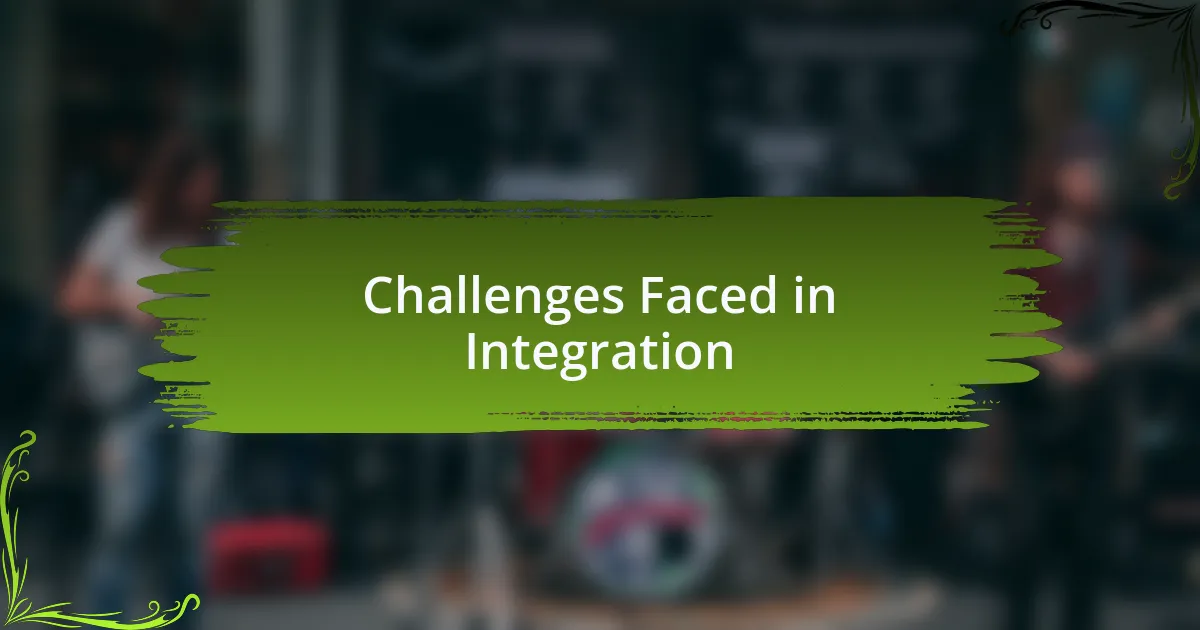Key takeaways:
- AI enhances creativity in music journalism, serving as a collaborative tool for analysis and inspiration.
- Integrating AI requires identifying tasks for automation, leading to improved workflow and more time for writing.
- Resistance and learning curves are common challenges when adopting AI, necessitating support and training for successful integration.
- Data privacy and ethical considerations are crucial in using AI for audience engagement without compromising trust.

Understanding AI in Music Journalism
AI is changing the landscape of music journalism in profound ways. For instance, I once used an AI tool to generate a detailed analysis of a new album’s themes and lyrics. The results were eye-opening; it felt as if a collaborator had joined me in dissecting the music, revealing layers I might have overlooked.
In my experience, AI isn’t just about efficiency; it enhances creativity. When I was struggling to find the right words for a feature on a lesser-known artist, I turned to AI for inspiration. The suggestions sparked ideas I hadn’t considered, reminding me how technology can be a powerful partner in storytelling.
Have you ever wondered how AI can make the writing process less daunting? I certainly have. By automating routine tasks like fact-checking or data gathering, I found myself with more time to focus on the art of writing. This shift not only alleviated stress but also reignited my passion for music journalism, showing me that embracing AI can be a game-changer.

Step by Step AI Implementation
When I decided to integrate AI into my business, the first step was identifying the specific tasks that could benefit from automation. I started with routine processes like organizing interviews and scheduling, which used to consume a lot of my time. By employing AI-driven tools for this purpose, I was able to streamline my workflow significantly, freeing up hours each week for actual writing and creative brainstorming.
Next, I explored AI’s potential in content generation. I was skeptical at first, but after testing different platforms, I found one that resonated with my voice and style. It was fascinating to see how the AI could create drafts that I could refine, often leading me to angles I hadn’t considered before. Have you ever been surprised by your own thoughts? That’s how it felt when the AI suggested new topics or connected me with trends that were bubbling just below the surface.
Finally, I began to analyze the data AI provided on reader engagement with my articles. Tracking how audiences interacted with my content was a game-changer; it informed my decisions on future topics and writing styles. By aligning my work with reader preferences, I not only created more relevant content but also fostered a deeper connection with my audience. It’s incredible how data insights can transform creativity into a more targeted and effective endeavor.

Challenges Faced in Integration
One significant challenge I faced during the integration of AI was resistance, both from myself and my team. While I was open to exploring the technology, some colleagues felt threatened by the prospect of machines taking over tasks they had traditionally done. It made me question: How can I best address these fears and help them see AI as a tool rather than a replacement? Ultimately, fostering a supportive environment and providing training sessions became critical steps in easing those concerns.
Another hurdle was the steep learning curve associated with new AI tools. The first time I tried to implement a content generation tool, I found it overwhelming. It was a stark reminder of that feeling we all have when faced with a new piece of technology. I had to invest time in understanding how to optimize the AI’s suggestions effectively. This experience taught me that patience is essential, and I had to embrace trial and error to find what truly worked for my writing process.
Moreover, data privacy issues loomed large as I began to collect user engagement metrics. The last thing I wanted was to compromise trust with my audience. I found myself grappling with questions about what information was ethical to gather. Balancing insightful analytics and maintaining transparency with my readers became a crucial aspect of my AI strategy. It was a complex dance, highlighting the importance of ethical considerations in the world of AI.

My Personal Experience with AI
When I first experimented with AI tools, I felt an exhilarating mix of curiosity and apprehension. I remember staring at the screen as the AI-generated content poured out, feeling both amazed and a bit apprehensive. Would this advance help me enhance my creativity, or would it dilute my unique voice? In those early days, I wasn’t just integrating software; I was also exploring my identity as a writer.
One moment that stands out occurred during a brainstorming session when the AI suggested an unexpected angle on a new music trend. I hesitated at first, doubting a machine could grasp the emotional nuances of music the way I did. But as I delved deeper into the suggestions, I found myself inspired by perspectives I hadn’t considered, reminding me that innovation often arises from collaboration—even when that partner is a line of code.
The transition wasn’t seamless; I faced days of frustration where the AI seemed to miss the mark entirely. Yet, each misstep taught me something valuable, instilling a sense of resilience. I often thought, what if embracing this technology could redefine my writing rather than diminish it? Learning to dance with AI instead of against it transformed my writing process profoundly, opening up new pathways for exploration and self-expression in music journalism.